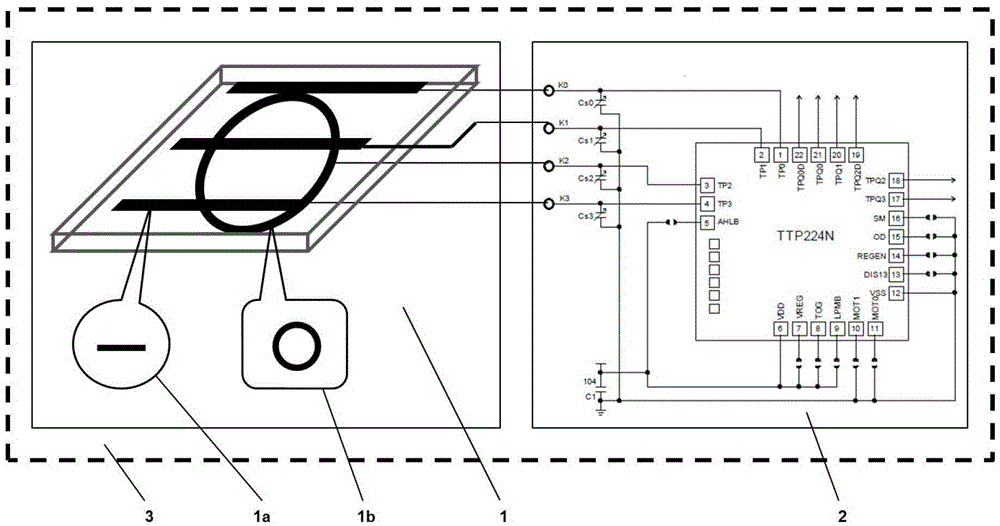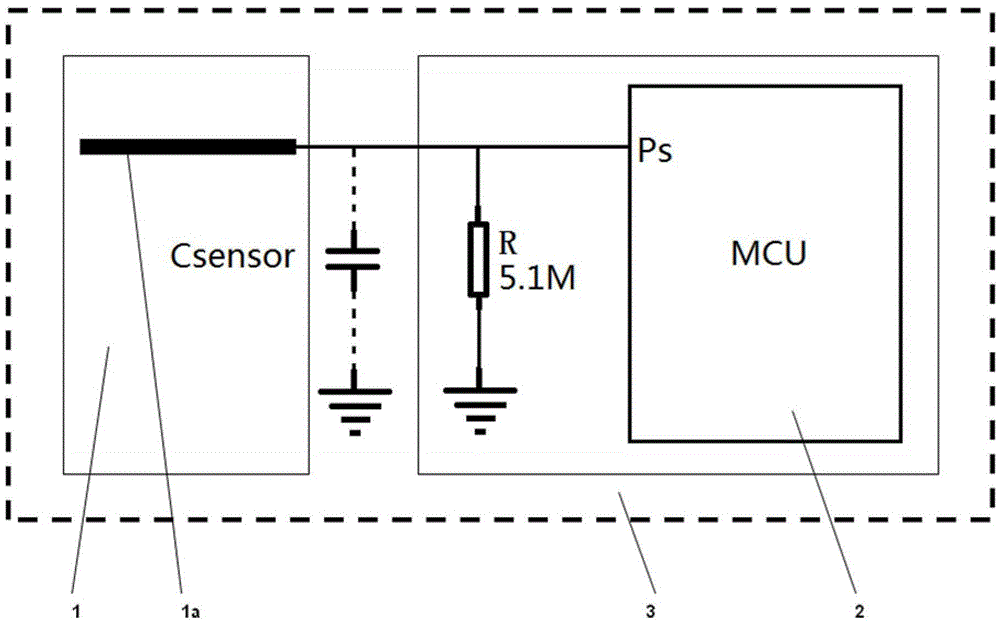Seating detection sensor, sedentariness prompting device and intelligent seat
A technology for detecting sensors and reminding devices, which is applied in the field of sedentary reminding devices, smart seats, and seating detection sensors, can solve the problems of unfavorable sensor cost, low accuracy, and inability to be placed in seats, etc., and achieves low implementation cost and satisfactory The effect of comfort requirements
- Summary
- Abstract
- Description
- Claims
- Application Information
AI Technical Summary
Problems solved by technology
Method used
Image
Examples
Embodiment 1
[0033]The seating detection sensor 3 of the present embodiment is made up of detection electrode 1 and signal processing module 2, is installed on the cushion, see figure 1 . In this example, the measurement object of the signal processing module 2 is self-capacitance, and only one electrode is needed to measure self-capacitance. For self-capacitance, no matter whether the human body is close or not, there is a relatively fixed distributed capacitance between the electrode and the circuit parts connected to the electrode and the ground, which is called static capacitance, and its size remains unchanged. When the human body is close enough to the electrode, the electrode and the human body will form a simple parallel plate capacitance, called body capacitance. Since the static capacitance and the human body capacitance can both be regarded as the capacitance between the electrode and the ground, the two are connected in parallel, and the self-capacitance is equal to the sum of...
Embodiment 2
[0041] The seat detection sensor 3 of this embodiment is composed of a detection electrode 1 and a signal processing module 2, wherein the signal processing module 2 does not use a dedicated touch sensing control chip, but is completed by conventional MCU software and hardware, and the measurement object is self-capacitance.
[0042] Application method see figure 2 , is to charge and discharge the self-capacitance through the I / O port of the MCU, and at the same time combine the I / O port interrupt and timer to detect the size change of the self-capacitance and detect the approach of the human body. In this method, the detection electrode 1 is an inline electrode 1a made of copper foil with a thickness of 0.065 mm, the length is less than 200 mm, and the width is less than 10 mm. The signal processing module 2 is a conventional MCU, and the leakage current of the MCU pin is required to be very small, not more than 50nA, otherwise it will affect the measurement of the capacitor...
Embodiment 3
[0045] The seating detection sensor 3 of the present embodiment is made up of detection electrode 1 and signal processing module 2, see Figure 4 , the measurement object of the signal processing module 3 is mutual capacitance, and a pair of electrodes is required to measure mutual capacitance. For mutual capacitance, the size of the capacitance is only related to the distance between two electrodes and the area of the two electrodes, and the size is fixed. The signal processing module 3 applies an excitation signal of several hundred kHz sine waves on one electrode. Due to the existence of mutual capacitance, the signal can be sensed on the other electrode through the electric field effect of the capacitance. The magnitude of the induced signal is the same as that of the excitation signal. The frequency is related to the size of the mutual capacitance. When the excitation signal is determined, the induction signal is only related to the mutual capacitance. When the human b...
PUM
 Login to View More
Login to View More Abstract
Description
Claims
Application Information
 Login to View More
Login to View More - R&D
- Intellectual Property
- Life Sciences
- Materials
- Tech Scout
- Unparalleled Data Quality
- Higher Quality Content
- 60% Fewer Hallucinations
Browse by: Latest US Patents, China's latest patents, Technical Efficacy Thesaurus, Application Domain, Technology Topic, Popular Technical Reports.
© 2025 PatSnap. All rights reserved.Legal|Privacy policy|Modern Slavery Act Transparency Statement|Sitemap|About US| Contact US: help@patsnap.com



